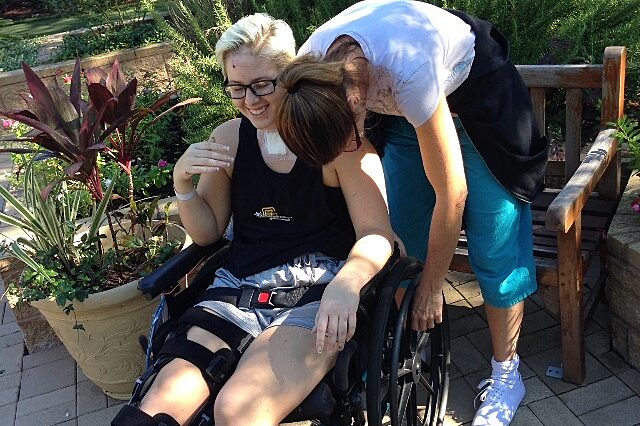Definition
A traumatic injury of the spinal cord can lead to spinal cord injury (SCI), which can be characterized by a bruise or a tear of the spinal cord. Spinal cord injuries continue to be a major danger to children, being a common cause of permanent disability and death.
Most spinal cord injuries occur in young people between the ages of 16-30, with the vast majority of those being males.
Children are seen at our Shriners Center of Excellence at UF Health, nationally recognized for its performance in pediatric orthopaedic care. Adults are seen at the brand new, state-of-the-art
UF Health Comprehensive Spine Center.
Types of spinal cord injury
There are two main classifications of spinal cord injury:
- Incomplete – Some function below the level of the injury. A person with an incomplete tear may retain the ability to move one limb or feel parts of the body that cannot be moved. Some amount of recovery is usually made.
- Complete – No function below the level of the tear. There is no sensation and no voluntary movement, although the patient can potentially regain some function with treatment and physical therapy.
Causes and risk factors
Traumatic spinal cord injuries are caused by a sudden and severe hit to the spine. An overwhelming number of cases in which people suffer spinal cord trauma are tied to motor vehicle accidents and slips or falls. Other causes are violent acts, sports-related injuries and medical procedures, among others.
Among children, there are other well-documented causes such as birth injuries, trampoline accidents and diving accidents.
Most spinal cord injuries happen as a result of these types of traumatic events, as opposed to non-traumatic events that come about gradually from internal damage to the spinal cord region (infections, cancer/tumors, congenital medical issues, etc.).
Symptoms
The location of a spinal cord injury will dictate the severity and type of symptoms that may present themselves. Oftentimes, the higher the injury is on the spinal cord, the more serious.
In cases involving higher injuries, there may be breathing problems as a result of respiratory muscles being affected. Lower injuries, like those that occur in the lumbar or sacral vertebrae, can impact nerve and muscle control in the legs, as well as bladder and bowel function.
Be alert to signs such as muscle weakness, as well as a loss of feeling or voluntary muscle movement in the arms, legs or chest.
Diagnosis
Please note that an acute spinal cord injury needs to be given immediate medical attention. Follow-ups should also be made for spinal cord trauma since neurological issues can arise.
Diagnosing a spinal cord injury is made by a detailed neurological examination, which can include various forms of radiological imaging of the spine in order to spot fractures of other injuries.
Diagnostic tests may include:
- Blood test
- X-ray
- CT scan
- MRI
Treatment
A traumatic spinal cord injury must first be treated by immobilization of the spine to prevent any further injury, which means stabilizing the head and neck areas. When putting together the treatment plan for a spinal cord injury, several critical factors are taken into consideration.
Things like the patient’s age can influence the strategy, as well as their general health and medical history. Other patient-specific factors include tolerance for specific medications, procedures or therapies. Of course, physicians will also discuss the patient’s opinions or preferences.
The injury itself will also help form the plan. Physicians will analyze the type and extent of the injury, while also forecasting its expected course.
There are a number of treatment options, including mechanical ventilators and feeding tubes, which can be used to help children or anyone incapable of breathing or eating/drinking.
- Observation and medical management
- Medications
- Mechanical ventilator
- Bladder catheter
- Feeding tube
- Surgery
Review Date
XX/XX/2020
Reviewed By
Dr. Laurel Blakemore, MD, Division Chief, Pediatric Orthopaedics.








